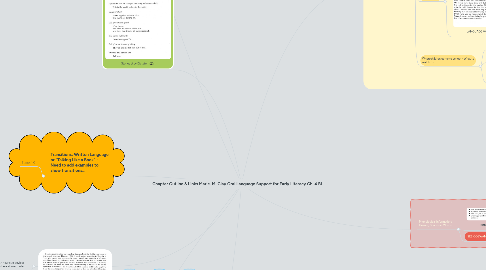
1. Stories they Dictate
2. Elkonin, 1973
2.1. "phonics" programs with heuristic devices (mental shortcuts) may be a slower route - tread carefully
2.1.1. Clay is not saying we don't teach children specifically about letters and sound relationships. She's referring to the programs we create with schemes we think makes learning easier, which may actually take a longer oute to
3. COMPLEXITY OF WORD ANALYSIS - MORE THAN A "RULE"
4. Observing Language
4.1. Language Tests
4.1.1. Sentence Structure
4.1.2. Vocabulary
4.1.3. Inflections
4.1.4. Articulation
4.2. Early Book Reading
4.2.1. Good Structure
4.2.2. Correct Copy
4.2.3. Self-Correction
4.3. Observe child in conversation.
4.3.1. Keep a record of most complex utterance on a regular basis.
5. Transitions: Written Language or "Talking Like a Book" - Need to add examples to show transitions...
5.1. Stages 1-5
6. Invented Spelling
6.1. Charles Read 1971
6.2. Writing - Sounds to letters and Reading letters to sounds
6.2.1. Cazden: How can we get young children to want to hear the sound segments in words and to search for these on their own initiative?"
6.3. Carol Chomsky - writing before reading...
6.4. 2017 Study Confirming Power of Invented spelling and Reading
7. Early Transitions
7.1. Children's Constructive Processes
7.1.1. Hypothesis Builders..Expressiveness and Complexity of Home Language pg. 70
7.1.2. Supporting Children Who Appear to Need Support
7.1.2.1. Don't talk more....misplaced sympathy to do the talking for them
7.1.2.2. Teachers/Caregivers work harder at engaging in genuine authentic conversation!
7.2. Adult's Roles
7.2.1. EXPANSION
7.2.2. Corrective Approaches Fraught with Problems
7.2.3. LANGUAGE VARIATION
7.3. When children come to school - What to watch for....
7.3.1. Understanding school register and beginnings of flexibly
7.3.2. Increasing complexity in semantics, syntax, and phonological, information.
7.3.3. Print or books have a particular way of sounding. "Once upon a time" -Books don't "talk" like I do...Talking Like a book.
